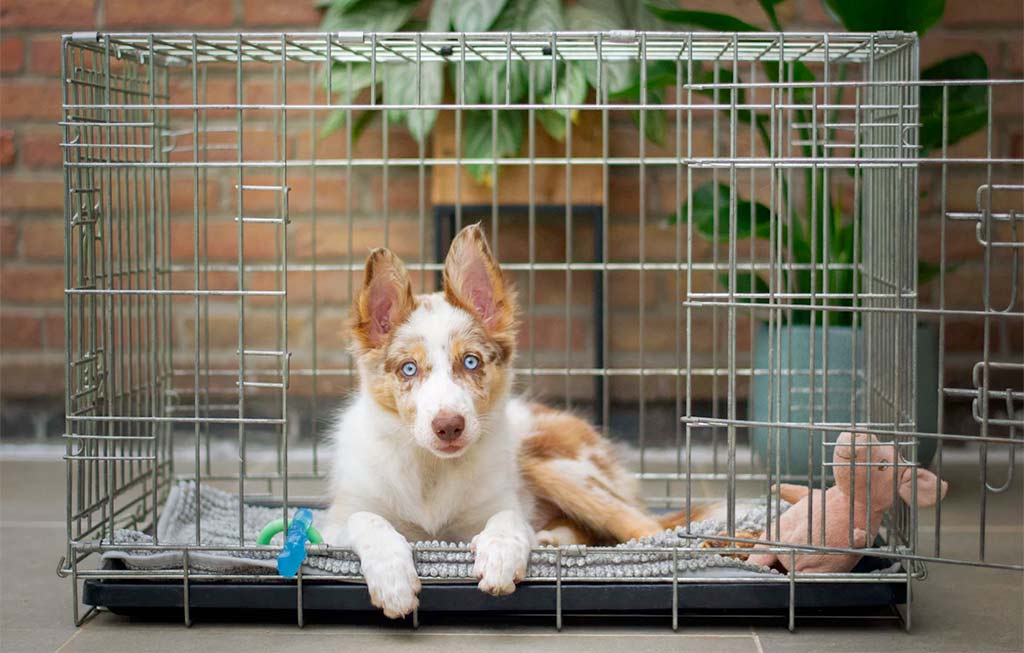
“Dear Team Doggy, my 9 month old lab is an escape artist! No matter what we do to keep her in the kennel she chews, digs, scratches, and does everything she can to get out. How do I stop my dog from escaping her crate?”
We were asked this question by a long time reader, Abby. We understand your frustration Abby. As much as we’d love to spend all day with our furry friends sometimes we need to leave them alone – we need to work in order to buy them lots of toys and treats of course.
If your dog destroys his or her crate when left alone there are a number of reasons they have this urge to get out. While it could simply be the crate is too big or too small for your dog. (Read how to size your dog crate) It could also be one of the following behavioral or psychological reasons:

1. Dogs want to be free and explore their surroundings
Dogs are curious by nature and want to explore absolutely everything. If that’s the case with your dog they may feel the need to break out of their crate because they simply want to see what’s just out of sight. This is immensely frustrating for us owners, who have dogs who escape from their crate repeatedly.
2. Dogs may feel cooped up and restless in a crate
Because of the need to explore dogs can feel restless or cooped up in their crate. It’s just like us when we have to stay inside on a nice sunny day because of work, school, or any number of unforeseen reasons we’ve unfortunately discovered in recent years. Like dogs, when we feel cooped up, we can get a little stir crazy.
3. Dogs may be anxious or fearful in a crate
Many dogs, especially young puppies develop separation anxiety. This means that when left alone they may begin to pant, pace, or whine excessively. This can be very distressing for both the dog and their owner. If your dog is experiencing separation anxiety they may try to escape from their crate in order to find you.
4. Dogs need to potty!
This is a biggie, I mean if I have to go to “tinkle-town” my worst fear would be to be stuck in a kennel. Well, you know what I mean. If your dog has to “go” and is left in their crate they may start to dig, chew, or scratch in an attempt to get out so they can relieve themselves. No one likes an accident, least of all your dog who may be scolded for it.
4. Dogs may see the crate as a place of confinement or punishment
If you’ve ever been scolded or punished while in a particular place, then you may start to associate that place with negative feelings. The same can happen for dogs who are constantly being put in their crate as punishment or for time-outs. They may start to see the crate as a place of confinement instead of a safe space and will want to do what they can to get out and give you cuddles and kisses until you forgive them.
5. Dogs may associate the crate with unpleasant experiences
If your dog is a rescue he may remember the crate or kennel as a “bad place.” If he has been left alone or constantly kenneled at a shelter he won’t soon forget. Some dogs with traumatic experiences in the past begin to fear being kenneled. These dogs may escape from their crate because they are afraid of being confined.
If your dog is displaying any of these behaviors, there are a number of things you can do to help them feel more comfortable in their crate and less likely to become a master magician every time you step out of sight.
Speaking of master magicians check out this crafty Houdini dog in this escaping crate video. Talking about a genius escape artist. Perhaps your dog is watching too many YouTube videos?
How to Stop Your Dog from Breaking Out of Their Crate or Kennel
If we could wave a magic Harry Potter wand so our dogs would love and trust their crate we would, but it can take time to get an escape artist to become content with her crate.
Step 1: The Distraction Method
First off you have your distraction methods. You can help your dog stop trying to escape by providing them with engaging toys and activities to keep them occupied in the crate. You can also make the crate a spa like oasis. I’m not talking about cucumber peels and a mud mask, but simply giving them a cozy blanket they associate with you will do wonders.
Step 2: Positive Reinforcement
You can also try training your dog to stay in the crate using positive reinforcement. You can do this by rewarding your dog with treats or verbal praise when they remain in the crate calmly. You can also try teaching your dog the “go to your bed” command and using that as a cue to go into the crate. Just as long as they don’t associate YOUR bed as their bed, as they might look at you with that cute but confused look.
Step 3: Overcome Separation Anxiety
If your dog is experiencing separation anxiety or fearfulness you’ll want to begin by slowly acclimating them to the crate. This means leaving them in the crate for short periods of time while you are still home and gradually increasing the time as they become more comfortable. It’s important not to force your dog into the crate, but rather to make it their own special place where they can go to relax.
This will require patience on your part, but eventually your dog should come around and begin to enjoy his crate as a safe place to relax. You can also try this relaxing music for dogs that is especially recorded t help with separation anxiety.
Step 4: Exercise – Hip Hop Till You Drop
Okay not literally until they drop, but a tired out dog from a good ole romp around the house, park, or yard will be magic for a dog who likes breaking out of their cage. Sometimes exercise is all they are missing. When they get some fun energy out they will be content taking a little snooze in their crate while you get some stuff done on your own.
Step 5: Potty Breaks-a-Plenty
If your dog is trying to chew her way out of the kennel it could simply be because they have to “go” and go bad. This is especially the case with young pups who don’t have the bladder control quite yet. Frequent potty breaks are key. Even if that means having someone stop by your house and letting the dog out while you are away until they master the pee-dance.
Step 6: The Last Resort
Sometimes you just have to go with the short term Alcatraz Method. That is, doing whatever you can to reinforce your crate so it is nearly impossible for your dog to break out. The methods above are great at fixing your escaping issue long term, but they can take time.
If you need to learn how to keep your dog in a crate right now because they are causing your house or themselves harm you can try to create a DIY escape proof dog crate or simply buy one of the best escape proof dog crates we have discovered in the article linked to here. (or, back there rather in the last sentence)
It turns out our fan and friend, Abby, was able to train her lovable lab to find peace and calm in her crate by combining a few of the methods we mentioned above. Way to go Abby! We are glad to hear everything worked out and your puppers retired her magicians cape.








